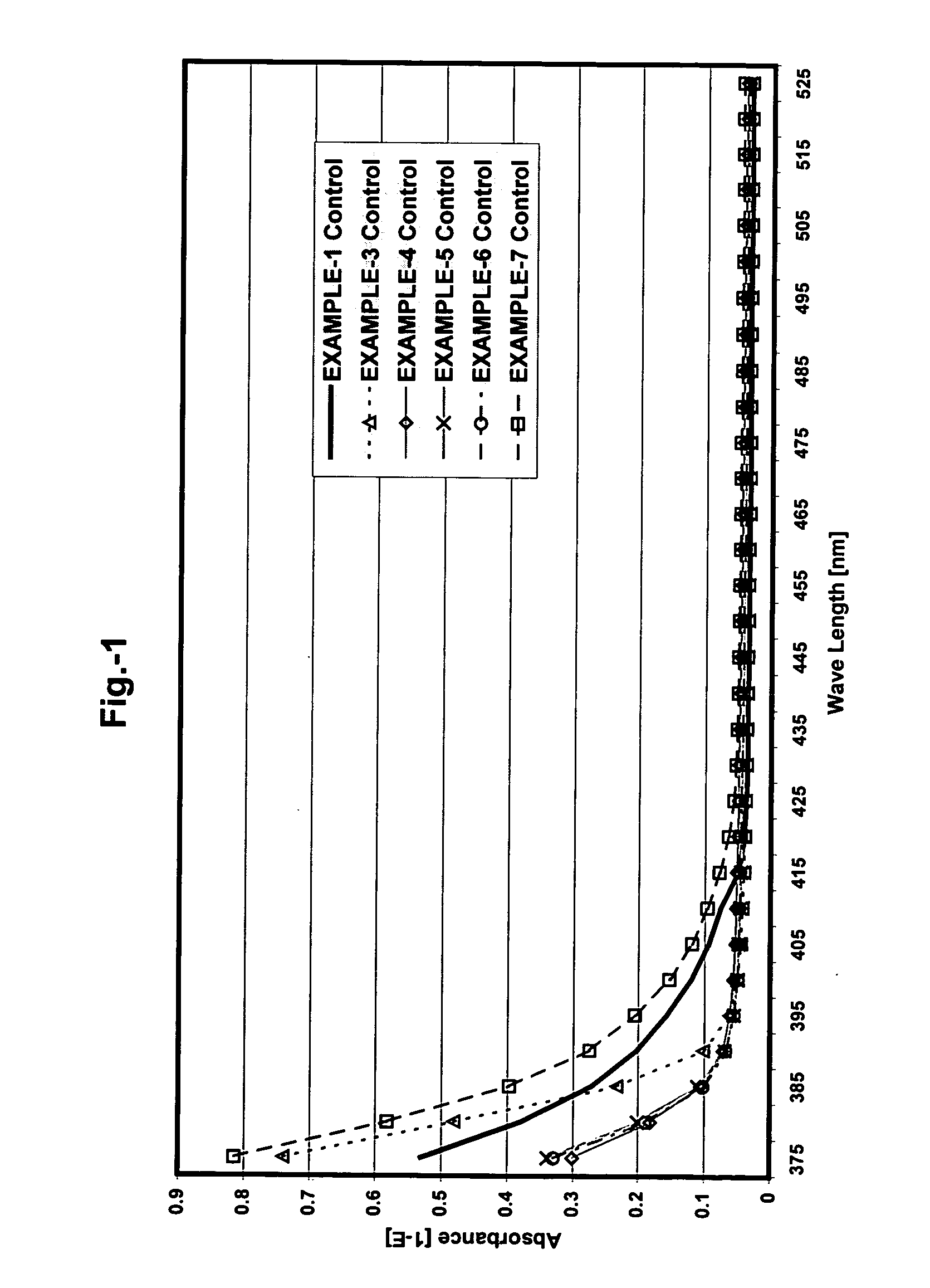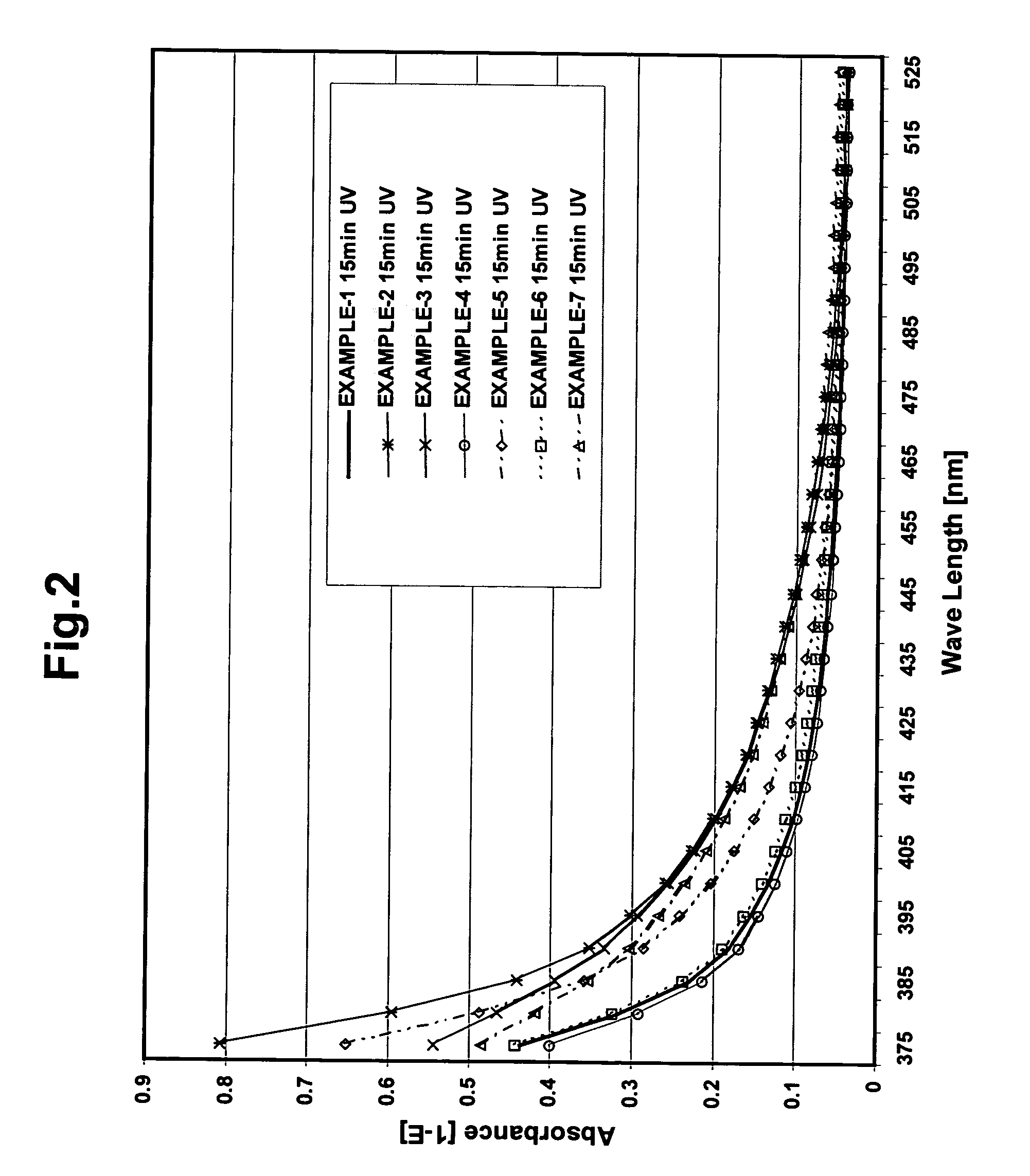Photosensitive composition with low yellowing under UV-light and sunlight exposure
- Summary
- Abstract
- Description
- Claims
- Application Information
AI Technical Summary
Benefits of technology
Problems solved by technology
Method used
Image
Examples
example 1
[0083] To 123.0 g of PREPOLYMER-1 obtained in Synthesis 1, there were added 55.3 g polypropylene glycol monomethacrylate (SR604, Sartomer Company, Inc.), 1.2 g trimethylolpropane trimethacrylate (SR350, Sartomer Company, Inc.), 7.0 g diethylene glycol dimethacrylate (AGEFLEX DEGMA, Ciba Specialty Chemicals Corp.), 0.32 g butylated hydroxyl toluene (BHT, Merisol Antioxidants LLC), 2.0 g Tetradecanoic acid (KORTACID 1499.01, Akzo Nobel), and 2.0 g photoinitiator Irgacure 754 (Ciba Specialty Chemicals Corp) (a mixture of 30-60% Oxy-phenyl-acetic acid 2-[2-oxo-2-phenyl-acetoxy]-ethyl ester and 40-70% -Oxy-phenyl-acetic acid 2-[2-hydroxy-ethoxy]-ethyl ester (Ciba Specialty Chemicals Corp.)). The mixture was thoroughly mixed to give a uniform photosensitive composition.
[0084] The viscosities, physical properties and Yellowing Index (YI) of the photopolymer resins and hand stamp plates prepared according to the formulation above were as follows:
example 2
[0085] To 124.0 g of PREPOLYMER-2 obtained in Synthesis 2, there were added 55.6 g polypropylene glycol monomethacrylate (SR604, Sartomer Company, Inc.), 1.07 g trimethylolpropane trimethacrylate (SR350, Sartomer Company, Inc.), 5.3 g tripropyleneglycol diacrylate (TRPGDA, Cytec Surface Specialties), 0.32 g butylated hydroxytoluene (BHT, Merisol Antioxidants LLC), 0.06 g 4-methoxyphenol (HQMME, Eastman Chemical Comp.), 2.0 g Tetradecanoic acid (KORTACID 1499.0, Akzo Nobel), and 1.04 g photoinitiator benzyl-dimethyl-ketal (Esacure KB-1, Sartomer Company), and the mixture was thoroughly mixed to give a uniform photosensitive composition.
[0086] The viscosities, physical properties and Yellowing Index (YI) of the photopolymer resins and hand stamp plates prepared according to the formulation above were as follows:
Viscosity22 000-32 000 cPHardness, Shore A 35-41Impact resilience 37-43%Tensile strength 900-1400 psiElongation 200-300%YI—Yellowing Index15 min UV-light 0.085530 min...
example 3
[0087] To 140.6 g of PREPOLYMER-3 obtained in Synthesis 3, there were added 25.1 g polypropylene glycol monomethacrylate (SR604, Sartomer Company, Inc.), 1.72 g trimethylolpropane trimethacrylate (SR350, Sartomer Company, Inc.), 7.25 g diethylene glycol dimethacrylate (AGEFLEX DEGMA, Ciba Specialty Chemicals Corp.), 0.36 g butylated hydroxytoluene (BHT, Merisol Antioxidants LLC), 18.1 g n-lauryl methacrylate (LMA, Sartomer Company), 4.1 g diethylaminoethyl methacrylate (AGFLEX FM2, Ciba Specialty Chemicals Corp.), and 0.5 g photoinitiator benzyl-dimethyl-ketal (Esacure KB-1, Sartomer Company) and 1.72 g benzophenone (Schweizerhall, Inc.), and the mixture was thoroughly mixed to give a uniform photosensitive composition.
[0088] The viscosities, physical properties and Yellowing Index (YI) of the photopolymer resins and hand stamp plates prepared according to the formulation above were as follows:
Viscosity28 000-40 000 cPHardness, Shore A 25-33Impact resilience 26-35%Tensile str...
PUM
 Login to View More
Login to View More Abstract
Description
Claims
Application Information
 Login to View More
Login to View More - R&D
- Intellectual Property
- Life Sciences
- Materials
- Tech Scout
- Unparalleled Data Quality
- Higher Quality Content
- 60% Fewer Hallucinations
Browse by: Latest US Patents, China's latest patents, Technical Efficacy Thesaurus, Application Domain, Technology Topic, Popular Technical Reports.
© 2025 PatSnap. All rights reserved.Legal|Privacy policy|Modern Slavery Act Transparency Statement|Sitemap|About US| Contact US: help@patsnap.com



